New perk! Get after it with local recommendations just for you. Discover nearby events, routes out your door, and hidden gems when you sign up for the Local Running Drop.
Art, dust, dancing, music and, oh, yeah, running the Burning Man Ultramarathon
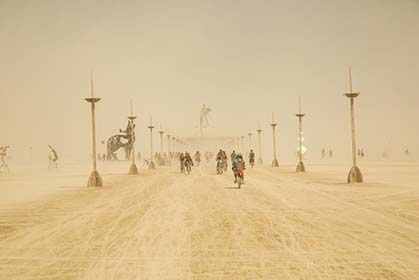
The dusty thoroughfare of Black Rock City, Burning Man’s temporary settlement. Photo by Jeff Clark
When I was a hardcore raver in New York City who scorned drugs in favor of dancing in tiny sequined miniskirts, I was told by one raver, “You’re pretty intense. You should go to Burning Man.”
“What’s that?”
“It’s a rave in the desert. Out West.”
This was back in the late 1990s, when you didn’t look everything up on the Internet (although it did exist), so I didn’t investigate much. I was a college student struggling to pay for textbooks, the occasional bus ticket to a rave outside of town and new running shoes every few months. A plane ticket across the country was definitely not in my budget.
Burning Man was forgotten. I eventually stopped going to raves, and focused most of my free time on running ultramarathons. I found freedom and happiness running through the woods, stumbling on rocks and roots, sharing my life story with strangers and eating things my non-running friends didn’t consider food. (Vanilla GUs are really delicious, I swear!) I also went to the occasional all-night dance party, frequented art museums, listened to electronic music, designed my own clothes and put together crazy outfits (blue-and-orange platform sneakers, shiny blue pants and a sparkly silver sweater, top it off with a sequined hat), but I never thought there’d be a place where I could put it all together.
Then, in 2007, a good friend came back from Burning Man. “It’s a playground for adults. Like a week of summer camp for grown-ups,” she gushed. “You’ll love it. Let’s all go next year!”
So I bought a ticket the next year, not sure what I was getting myself into.
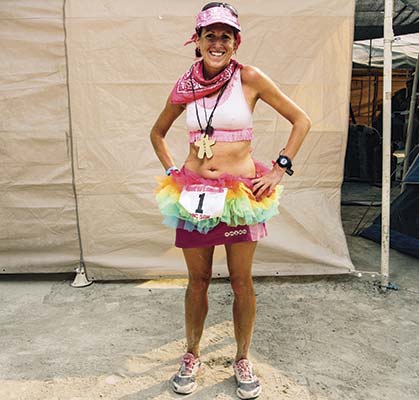
The author and Burning Man Ultramarathon RD, Cherie Yanek. Photo by Jeff Clark
I arrived in Nevada’s Black Rock Desert that August in a dust storm. No one could drive in the blinding conditions, so we were stuck at the gate for hours. While we waited, I handed out M&Ms to strangers and embraced the dust, which covered me and turned my long hair into a giant knot. Someone gave me a squeezing hug, lifting me up in the air and spinning me around in circles until I felt dizzy. A stranger told me I needed a necklace, and slid a string with a mini-effigy of “The Man” over my head. After we got through the gate, found our camp and pitched our tents, I went for a walk around “Black Rock City,” the festival’s popup settlement.
For most of the year, there is nothing out there—no people, plants, animals or bugs. Just the playa, a flat, dried-up lakebed surrounded by mountain ranges and a two-lane country road. The closest town, Gerlach, has a population of 100. But for a week every August, Black Rock City is the fifth most populous city in Nevada, with 66,000 inhabitants.
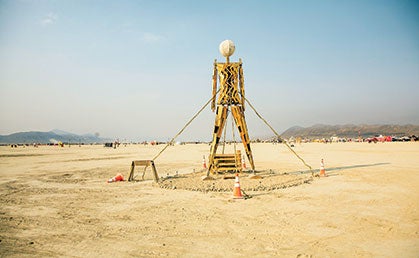
One of many sculptures on the dusty playa. Photo by Jeff Clark
Burning Man isn’t your typical arts-and-music festival. International DJs come in to play for free because, as mashup master DJ Lobsterdust once told me, “It’s the best party ever.” “No spectators,” is a common saying at Burning Man, and the art frequently requires interactivity—turning cranks, banging drums, yanking pulleys, writing, meditating—to fully experience it. Art pieces over the past 10 years have included oil derricks, slides, a giant hammock and a light-up, remote-controlled Rubik’s Cube, not to mention the various wooden sculptures lit on fire and burned. Burning Man lives by its own set of “principles,” among them “radical inclusion,” “decommodification,” “radical self-reliance,” “radical self-expression,” “communal effort” and “leave no trace.” Nothing can be bought except ice and coffee.
The festival started in 1986 when a group of friends burned an effigy, now known as “The Man,” on San Francisco’s Baker Beach. Stories about the reason behind this vary: sometimes it’s said the effigy stood for an ex-girlfriend; other times, “just because.” The festival moved to the Black Rock Desert a few years in, after the San Francisco police shut down the effigy burning. (The Man is still burned every year at the end of the festival.)
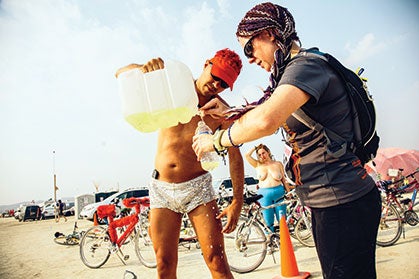
Volunteers in sequined boxer briefs are just par for the course. Photo by Jeff Clark
Exploring Black Rock City that week, I climbed on giant, seemingly unstable sculptures, drank cheap alcohol mixed with Kool-Aid and bounced on trampolines. People offered me free advice, sometimes good, sometimes not. I got advice from a man who called himself “God” on how to end a dying 10-year relationship. I learned how to give a Thai massage. I made a necklace in a shiny dome during a dust storm, attended a stuffed-animal dissection workshop and won two dildo fencing matches.
I was served at the Conversation Snack Bar, where topics and conversations were the only things on the menu. I ate grilled cheese from the back of an “art car,” and slices of salted cucumbers from an “art bike.” (Burning Man’s DMV—Department of Mutant Vehicles—mandates that vehicles at the festival should not actually look like vehicles at all, so “Burners” transform their cars, trucks and bikes into birthday cakes, boom boxes, stadiums, cats, yellow submarines and everyone’s favorite, the flaming octopus.) I felt plain in my halter top and miniskirt; others wore shiny holographic fabrics, leather corsets or shirts with no pants. This was definitely not what I had expected.
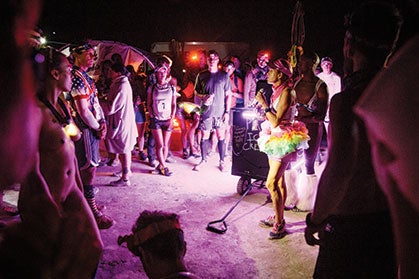
Not your typical pre-race meeting. Photo by Jeff Clark
That first year, I also won a 5K. The race was put on by a laid-back chemist who had us run in a straight line through Black Rock City, past The Man. Basically, we just ran through the middle of the craziness for 3.1 miles.
At the finish line, as I drank a cup of water and sat on the case of PBR that I had just won, I told someone, “There needs to be an ultramarathon here.” True, it was boiling hot, and I was exhausted—loud electronic music was blaring at pretty much all times of day. But this place was magic. I watched a naked man and a woman wearing a shiny green cat suit and goggles ride a tandem bicycle covered in neon-orange fake fur. They were shooting people with a water pistol. A little kid almost ran into the bicycle, and screamed with joy. Her mother hula hooped behind her.
I quickly got Burning Man. This was a place where people brought their passion—be it making pancakes for hundreds of people, DJing electronic music at dawn or teaching others how to make their own voodoo dolls—and if you want something to happen, you make it happen. I was covered in dust, but I could see what I wanted.
At that first “Burn,” a friendly guy named Rich stopped me to offer me water, and then befriended me. After hearing me ruminate on my crazy desire for an ultramarathon, he offered to help. I squeezed Rich in a tight hug.
“Let’s make this happen,” I said.
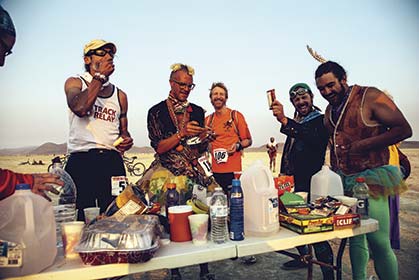
Traditional aid-station snacks at a non-traditional aid station. Photo by Jeff Clark
I built a webpage and a Facebook page, and believed they would come. I sent a submission to the Burning Man newsletter, Jack Rabbit Speaks. (They introduced my entry with, “Are you batshit crazy?”) I had long discussions over margaritas with my Burner friend Rachelle about the best time to start the race, and asked her to design medals. I ordered free numbers from Race Ready, because everything was coming out of my pocket, and my pocket wasn’t very deep. So that I could run, Rich offered to step in as race director during the race.
Burning Man’s Emergency Services Department had questions, but seemed excited. “This is awesome! It makes Black Rock City seem like a real city now, with a sporting event,” Joseph Pred, Operations Chief of Burning Man’s Emergency Services Department at the time, told Rich and me.
Pred wondered if we’d need ambulances on the race course; he was an EMT in the real world who had worked at marathons and seen the carnage at finish lines. “Nah,” I told him. “Ultramarathons are different. People tend to not push it in that same way.”
I don’t think he understood that in the “default world” (what Burners call the world outside of Burning Man), you’ll see ultrarunners walking, and it’s not uncommon for aid stations at ultramarathons to have alcohol. Burners and ultrarunners might be a lot more similar than most people think: they skip a lot of the routine stuff—“Where are you from?” “What do you do?”—and get straight to the stuff that matters—“Are you happy?” “What’s your passion?” “What’s your dream?”
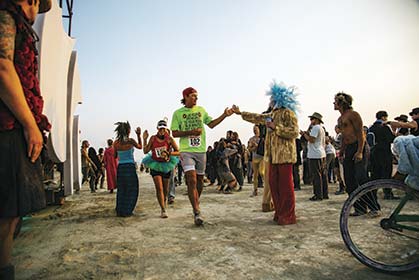
Burning Man’s take on a race chute. Photo by Jeff Clark
In 2010, the first Burning Man Ultramarathon 50K started 40 minutes late, at 5:40 a.m., under The Man. Thirty-three runners ran four loops across deep playa—the part where there’s nothing but space and amazing art—and along the Esplanade, the Main Street of Black Rock City. We knew we couldn’t have an aid station at The Man, because there would be too many people helping themselves to free bananas, energy bars and gooey homemade brownies. We placed the aid station way out in deep playa, where the volunteers got sunburnt while filling bottles with sticky electrolyte drinks. The drop bags weren’t at the finish line, as Rich was still patrolling the course and the bags were in the back of his truck. Some people didn’t get their medals (I mailed them later). Runners hugged me, told me it was the highlight of their week, the best race ever.
Why didn’t it feel like success?
Over conference calls, at cafés and in my living room, I had meetings, official and unofficial. I talked with friends, with runners. I accepted criticism. I wanted to make the Burning Man Ultramarathon a real race, one ultrarunners would respect.
In 2013, the race’s fourth year, we had 79 finishers, up from 33 the first year. Afterward, in a mess of tangled medals, snacks and crushed gallon jugs, I murmured to one of my campmates, “What will this be next year?”
One of the runners, Ryan Van Duzer, made a video about the race that went viral, and people started signing up. (“I’m batshit crazy,” one of them wrote me.) Before I left for the playa, over 230 people had registered.
“Is this course certified?” one of them emailed to ask.
Hardly. Nothing at Burning Man is certified.

Beth Weinstein (left) jumps for joy as Gina Kremer looks on. Photo by Jeff Clark
We got to the playa on Thursday before the festival even began. Early mornings found me running loops of the course with two Garmins strapped to my wrist, and, at sunset, I biked the course with the Garmins and my bike odometer. The race would begin at Pink Lightning, our camp, at the intersection of 7:00 and D streets. Black Rock City is a horseshoe shape; streets parallel to the Esplanade are labeled A-L, and intersecting streets are named after times of day. Runners would run down D until then hit 7:30, where they would make a right, then a left on the Esplanade. They would pass some of the bigger camps on the playa, like “Slutgarden” and “Bubbles and Bass.” Then, where the Esplanade ended, they would run in the open playa until they hit the orange trash fence that borders the event. After three or four miles, they would come back into the city to complete the loop. Because the size of the playa varies from year to year, the course needs to be measured annually. It was the same mileage every time I biked or ran it: seven miles.
In the days before the race, runners came by to pick up their numbers and chat. We had runners from the United States, Japan, Australia, England, Germany, Canada, and Mexico. They each brought a gallon of water and a running snack to share; Pop Tarts, cookies, chips, pickles, energy gels and countless varieties of trail mix piled up in the common area at my camp. My voice grew hoarse from repeating the same phrase so many times: “Sign here that it’s OK if we use your photos.” “Pick a number, whatever you want.” “Yes, it’s real chip timing.” “Yes, you must carry water.”
Many were new to ultrarunning, and some did not think they could finish. With all my persuasive power, I urged people to at least try, at least start, and my coach and good friend, the legendary Ray Krolewicz, who has won more than 80 ultras, helped. “Here, you get a starting medal, just for starting,” I’d say, in an effort to bribe them.
I set my alarm for 3:15 the morning of the race, but woke up every 20 minutes to look at my watch. When I finally got up, I threw on a sports bra with hot-pink fringe, shiny pink booty shorts and a pink tutu, with a thick layer of lube underneath. It was cold, so I wore a sparkly sweater until the race start.
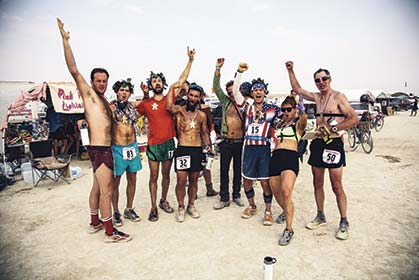
The fastest runners get the party started with pacers and volunteers. Photo by Jeff Clark
Unlike other races, where most runners dress in running clothes, the vast majority of people at the Burning Man Ultramarathon wear costumes—sparkly clubbing clothes, fake fur, tutus—or nothing at all. (Thankfully, most of them know the importance of lubing up). That year, we had a Trojan warrior, a pretzel and even a businessman with a suit, tie and briefcase.
I gave the race speech. I forgot to say important information and thank certain people. I gave a final overview of the course, and reminded runners to let someone know if they dropped. I was almost in tears, moved by the large crowd that had shown up.
With “On Your Marks. Get Set. Go!” we began running across the playa, talking and interrupting each other. It was dark, but our headlamps, and the cars covered in el-wire floating by, lit the way. We gave high fives to the lit-up souls still dancing, and danced while we ran to the music. We heard shouts of, “What are you doing? Why are you running? Stop, come dance!” People held stop signs. A gorilla on a bicycle yelled for a hug. Yes, the city was partying, but so were we, in our own way.
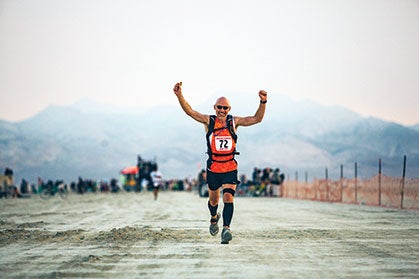
Photo by Jeff Clark
Adjacent to the aid station, a pirate-themed art car was blasting music. People cheered us on, offering us shots and hugs. One of the most popular musical art cars, “Robot Heart,” was stationed next to the race course. A runner named Rich Previte, who was running the race naked, left the race course to dance with Robot Heart for a while. Another, Sara Poindexter, left to dance to DJ Scumfrog. “Angels” set up spontaneous, unofficial aid stations all over the course, handing out water, snacks, whiskey and cigarettes.
“Every time around, it was a completely different experience,” Kim McCoy, the lady in the pretzel suit, later said. “It starts when it’s dark, and you run through some amazing dance parties, then watch a beautiful sunrise. The third time around it is quiet and peaceful, and you just do a lot of self reflection. Then, [on] the last loop, the party has started again!”
“All in all,” says Kerry Winston Ward, who ran Burning Man in full business attire as a warmup for the following week’s Tahoe Rim 200-miler, “it’s like any other ultramarathon that would be run on a desert planet inhabited by insane, colorful aliens.”
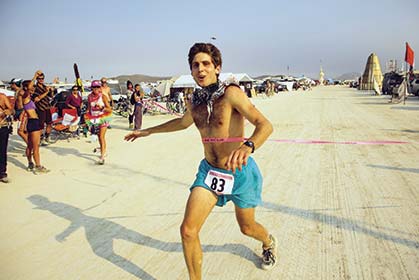
2013 winner Shaun Maguire crosses the finish line. Photo by Jeff Clark
Andrew Utas, the first runner, finished in 3:38. The lead cyclist couldn’t keep ahead of him to lead on the first lap; he was that fast. Kathy D’Onforio won the women’s race for the third time, and ran her fastest Burning Man time yet. Kathy, who has won various ultramarathons (sometimes outright), is also a talented sculptor; a few days before, she had put the finishing touches on her piece, “Alien Sanctuary,” several brightly painted, six-foot-tall papier-mâché vultures adorned with crystals, watching over dead aliens among cats and flowers.
We had prizes for the fastest naked runners, the best costumes and the sexiest runners. Runners wearing medals, necklaces, headbands and other donated race swag hung out under the pink shade structure, grateful for a cooler spot to lounge in. A runner who took the year off from running Burning Man catered the post-race meal, an array of Mexican dishes piled with guacamole.
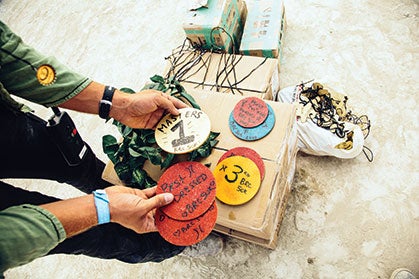
Handmade wreaths and medals. Photo by Jeff Clark
“You’ve done something special,” legendary marathoner and race director Gary Allen told me. Allen, who has run a combined 36 Boston and New York City Marathons, called the race the “most epic experience I have ever been a part of.” Chris Danesi, a triathlete who has competed in the Ironman World Championship in Kona, Hawaii, told me, “I would do this every year. I wouldn’t do Kona every year.”
As people finished the race in tears, they would seek me out for sweaty hugs and profuse thank yous. Two different people told me it was the best day of their lives. I knew then that we were not like a real race—we were a real race.
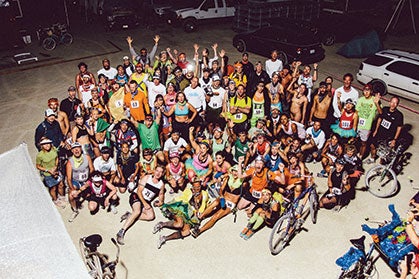
Photo by Jeff Clark
And then it was over. The last runner, Benjamin Timoner, came in at 10:07 with the biggest smile on his face. He got the Scott Sanders Award, a rock named after the runner who, having proudly finished in last place before, donated it. Afterward, my campmates and I went biking, climbed pieces of art, took photos and avoided a scary clown who was talking like a duck. My boyfriend and I danced and drank mojitos and rode in art cars in dust storms and meditated in deep playa at night. I went for runs around the city in my underwear and won the 5K. I hula hooped and put on too much eye shadow and stayed up past dawn to watch pieces of art go up in flames. The Burn went on.
Cheryl Yanek is a librarian and writer living in Brooklyn, New York. She loves being the race director of the Burning Man Ultramarathon, and recommends running in tutus whenever possible.
This article originally appeared in our April 2015/DIRT issue.